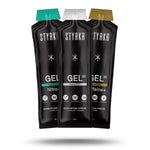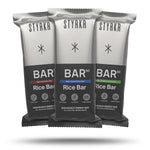With tips from registered dietitians to help you perform your best.

If you’re participating in a multi-day endurance event or planning a solo bikepacking trip, there’s one thing that will improve your performance, energy levels, and overall enjoyment.
That’s your nutrition.
If you get your nutrition wrong, you’ll feel lethargic, your performance will decline, and the long stretch of road you were looking forward to will seem longer and longer as you get more and more tired.
I spoke to two sports dietitians for advice on how to fuel for a multi-day endurance event or bikepacking trip. This article explains everything you need to know to get your nutrition correct.
What you will learn:
-
The nutritional demands of ultra-endurance cycling
-
What and how much food to eat when cycling
-
The importance of hydration and electrolytes for multi-day cycling
-
Common nutritional mistakes to avoid when cycling long distances
What makes ultra-endurance cycling so demanding?
Ultra-endurance cycling is very demanding. It’s physically and mentally exhausting, requiring exceptional physical and cardiovascular endurance. As riders typically ride for several hours a day for multiple days, this increases their nutritional needs.
You’re not only eating for your ride, but you want to fuel for recovery and performance the next day.
Additionally, sleep deprivation, weather exposure, and other external factors can also increase the demands on the rider. It’s also common for ultra-endurance cyclists to experience a reduced appetite. However, not eating enough can affect performance and lead to increased lethargy.
It’s quite the conundrum.
How you manage your nutrition is absolutely critical for multi-day endurance performance.
How much should you eat?

You should eat before, during, and after cycling to maximise performance and recovery.
“For multi-day endurance events, athletes should aim for 60 to 90 grams of carbohydrates combined with a small amount of protein and fat per hour,” says Jena Brown, RD, CSSD, an endurance dietitian and owner of Victorem Performance Nutrition in Brenham, Texas.
Eat a combination of real food, such as rice or tortillas, and sports products, including energy gels, chews, bars, and carbohydrate-rich sports drinks.
It’s important to train your gut during training to avoid gastrointestinal upset during an endurance event or when bikepacking for the first time.
It’s very likely that when riding for hours across several days, you will experience flavour fatigue — this is when you no longer enjoy the food you’re eating. This can make it very difficult to take on enough calories to fuel your performance.
You may also feel like you've lost your appetite.
To combat both of these, it’s essential to pack a mix of food and snacks.
If you don’t want to eat another rice cake or tortilla, choose an energy gel like GEL50.
If you can’t stomach food, consider a carbohydrate drink mix, such as MIX+, which contains 30g of carbs per serving and added electrolytes to support your performance.
There are always options to get a quick and easy source of carbohydrates for extra energy.
What to eat during an endurance race
You know how much you should eat, but what foods should you eat and how often?
Brown recommends carbohydrate sources to include a mix of glucose and fructose-based carbohydrates from multiple sources, and foods can be from supplements, supplements and food, or food only.
She provides two sample fueling examples below:
| Item | Calories (kcal) | Carbohydrates (g) | Protein (g) | Fat (g) | Notes |
|---|---|---|---|---|---|
| 1 medium banana | 104 | 27 | 1 | 0 | |
| 1 whole-food protein energy bar | 240 | 34 | 10 | 7 | |
| 600 mL water + low-sugar electrolyte | 0 | 0 | 0 | 0 | ~500–600 mg sodium, 0 g sugar |
| Total | 344 | 61 | 11 | 7 |
| Item | Calories (kcal) | Carbohydrates (g) | Protein (g) | Fat (g) | Notes |
|---|---|---|---|---|---|
| 1 energy gel | 120 | 30 | 0 | 0 | |
| 1 whole food energy pouch | 180 | 21 | 5 | 4 | |
| ½ to 1 dark chocolate energy bar (chocolate and nuts) | 170 | 15 | 2 | 11 | Based on half to full bar |
| Total | 470 | 66 | 7 | 15 | Approximate based on range |
How to carry fuel for a multi-day ultra-distance ride
“For multi-day ultra events, think of your bike bags like your pantry — they need to hold a variety of carb-rich options that you know your gut can tolerate under stress,” says Melissa Boufounos, CHN, sports nutritionist and owner of MB Performance Nutrition near Ottawa, ON.
Packing a variety of foods and snacks can also help avoid flavour fatigue.
Boufounos recommends a mix of real foods and performance products, like baby food pouches, cooked salted potatoes, and dates, as well as your standard energy gels and bars. She recommends eating perishables earlier in the day or keeping them in an insulated pouch for when you need them.
Use aid stations when possible
“If you pass an aid station and aren’t hungry, grab food anyway — future you will thank you. And remember, your hydration strategy matters just as much. Use your bottles or hydration bladder to sneak in carbs, essential amino acids, and electrolytes between bites,” says Boufounos.
It’s a good idea to research aid stations ahead of time to make your fuelling strategy that much easier.
If you’re bikepacking solo or with a small group, look for petrol stations, supermarkets, and other shops on the way.
Plan ahead
“Don’t rely on hunger cues during ultra events — you’ll fall behind. Set a timer for every 45 minutes as a reminder to eat or sip on carbs. Start the day with a solid breakfast at least two hours before the race or ride,” explains Boufounos.
Planning ahead will make your life a lot easier. It also means less thinking when the fatigue kicks in.
Nutrition mistakes to avoid for multi-day cycling
Ultra-endurance cycling events are longer and therefore make it more likely you’ll make mistakes, especially surrounding nutrition.
Here are some common mistakes to avoid:
1. Overhydrating without electrolytes
“Drinking excessive plain water can dilute sodium levels and increase the risk of hyponatremia, especially during long, hot stages,” says Brown.
She recommends pairing fluid intake with adequate sodium replacement, personalised to the individual's sweat rate and sodium loss. Electrolyte products, like SLT07, increase sodium and other essential electrolytes to support performance.
2. Not eating enough calories
It’s very likely that you won’t be able to consume enough calories when riding for multiple days.
Even if you ate every hour, you would probably still need more food.
Flavour fatigue can make this problem worse so pack lots of snacks and a mix of foods to keep your energy levels high.
Also, ensure you’re eating real meals as well as snacks during the day. Breakfast and dinner are two excellent options for loading up on carbs.
3. Overloading the gut with the wrong type of calories
Too much — or not enough — of anything can cause GI distress. Athletes should practice with different combinations of carbohydrates, fats, fibre, protein, and supplements during long rides before the event to train their gut,” says Brown.
Practice eating on long rides and try a mix of foods to see how your gut responds.
Once you know what works for you, don’t change it.
Also, avoid trying new foods or drinks during a multi-day event. Stick to what you know to prevent any last-minute stomach upset.
4. Not eating regular meals
It’s easy to neglect eating regular meals when riding for a long time or over multiple days.
Brown explains the importance of regular meals below:
“A short-term calorie deficit during single-day races is common and manageable. But in multi-day endurance events, calorie and nutrient deficits quickly stack up, leading to major health and performance concerns. Regular meals support recovery between stages, provide sustained energy, refill glycogen stores, stabilise hormones and immune function, and improve gut resilience and mood.”
Key takeaways
-
When cycling for multiple hours over several days, proper nutrition becomes absolutely essential for performance, fatigue management, and recovery
-
Additional factors, like a lack of sleep and a reduced appetite, make multi-day endurance events more challenging
-
Eat 60 to 90 grams of carbohydrates per hour when riding, eating a mix of whole foods, sports products and snacks
-
Carry fuel in your saddle bags and plan where to stock up on extra food if needed en route (petrol stations, supermarkets, etc.)
-
A common mistake many ultra-endurance cyclists make is overhydrating without electrolytes — this can cause hyponatremia
-
Eat whole food and regular meals before and after riding to better manage nutritional demands

